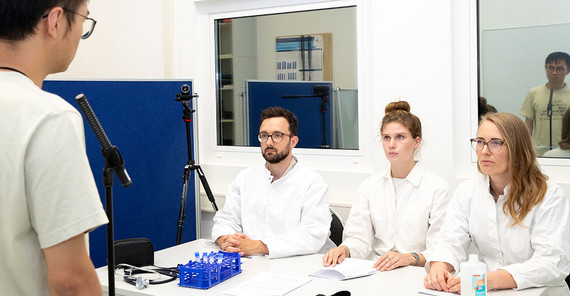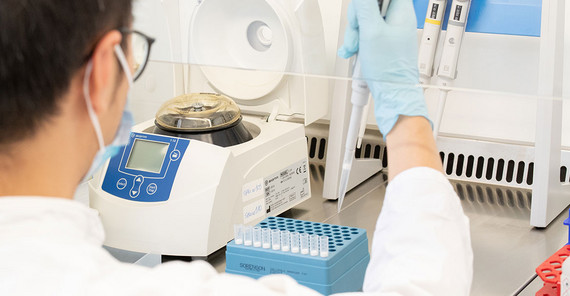“The test is meant to trigger stress,” Prof. Wippert explains. “Because this is what we want to measure.” Among other things, this happens due to the hormone cortisol, which makes us perform better when it matters. In such situations, the body releases cortisol as well as noradrenaline and adrenaline. The brain then quickly receives glucose so that we can concentrate and work under pressure. Cortisol also increases blood pressure, accelerates the breathing rate, and makes the heart pump faster. At the same time, the stress hormone has a positive effect on the immune system and inhibits inflammatory processes. It can be detected in saliva, for example. This is why up to eight saliva samples are taken before, during, and after the test – depending on what the researchers are analyzing – to determine how the cortisol level develops. As it takes some time for the hormone to take effect in the body, the stress test actually begins before the interview: the test subjects prepare themselves alone, not knowing what to expect. At this point, the body already flips the switch. Ten minutes later, things are really getting started.
Three people enter the room, sit down on chairs behind the table, put documents in front of themselves. Then a young man comes in and is asked to stand in front of them at the microphone. He looks tense, trying to remain calm. The three facing him look stern, expressionless. That certainly doesn’t help. He is asked to count backwards, quickly. He looks visibly stressed, the examiners unhappy. Even watching the scene is stressful. How might the “examinee” be feeling?
Stress has its good sides – in moderation
In fact, we experience stress reactions on different levels,“ Wippert says. “Emotionally, for example, it directly affects our mood, but also cognitively because we evaluate and review the situation immediately.” The physiological reaction most frequently associated with stress is itself complex. After all, five hormonal axes are involved and become imbalanced – quite deliberately – through the release of cortisol & co. Because stress is not bad per se, the researcher points out. “We need a certain amount of tension in order to be able to adapt to different situations. If we are healthy and have sufficient resources, we are not ‘stressed’ but continue to develop.” Our body actually has systems, its own feedback loops, with which it can stop the release of cortisol and restore balance. Stress becomes a problem when it catches us off guard, when our body is exposed to stress peaks too often or too strongly. Children and adolescents are particularly susceptible to this in certain phases of development, Prof. Wippert explains. “Especially in the early phases of our development, the brain undergoes major changes and interacts directly with the development of the hormonal axes. Strong stress reactions, such as those caused by early childhood trauma, can lead to dysfunctions, i.e. to a reprogramming of the functional level of the hormone axes, and thus have lifelong effects.” But constant cortisol release is not good for adults either. “If there are no longer any resting periods in which the body can find its balance, or if a serious event leads to very strong stress reactions, there are overstress and wear-out effects.” The fact that we are brought to our knees under constant stress is called “allostatic load” in research. This in turn can make us ill in various ways: Cardiovascular, autoimmune, and mental diseases and diabetes are now linked to stress, as is damage to bones, cell regeneration, the digestive tract, and DNA. Stress literally destroys us.
Stress makes us ill on a number of levels
Among other things, Prof. Wippert researches what stress “does” to our bones, and she has discovered something astonishing. “We were able to show that bone metabolism changes in people under high stress levels and that the density of bones can decrease.” Their bones grow more slowly, break more quickly, and heal less well. In general, the ability of the body to regenerate suffers when there is a lot of stress. There were even different patterns of damage. “People with childhood trauma have a different pattern than people under constant stress,” Prof. Wippert says.
A second important focus for the team is how stress affects other diseases, such as those that affect our muscles and skeleton. “Pain-related diseases are ‘number 1’ worldwide. And their numbers will increase,” Prof. Wippert says. “Currently, around 540 million people worldwide suffer from non-specific lower back pain alone.” In various projects such as MiSpEx and currently RENaBack, she and her team have researched how stress fuels the development of chronic pain. This actually happens in various ways, such as a tissue-related change in nerve fiber quality, a neurotransmitter imbalance, or an increasing neuronal activation in brain centers that are simultaneously involved in the processing of stress and pain stimuli.
In order to understand the exact mechanisms behind these processes, the researchers have now examined up to 5,000 people from the general population as well as patients in rehabilitation clinics. They analyzed blood, hair, and urine as well as microRNA for stress markers. In addition, they extensively interviewed those affected and often followed them for several years. “This enabled us to reduce the number of possible psychosocial factors that are important for the transition from an acute pain episode to a chronic course from 250 to eight,” she says. “The social situation, vital exhaustion, critical events, and stress play an important role,” especially factors that are significant for a person’s sense of coherence. From this, the team developed diagnostics as an early warning system and an intervention that helps those affected to stabilize their permanently unbalanced system again – through moderate, individually adapted training. “Patients suffering from pain are often unable to exercise at all,” the researcher says. “But it's exactly about getting them moving and training so that the system restarts.” The diagnosis helps to find the right therapy modules for multimodal training based on the personal psychosocial risk profile. This contains modules that combine physical activation with cognitive training: Patients have to perform physical exercises and at the same time solve tasks that train their working memory. “MRI images have shown that this activates the frontal cortex and simultaneously reduces activity in the pain network,” Wippert explains. The provoked new neuronal activation patterns erase traces of pain and enable people to train in the pain-free range. They literally forget about the pain and do not perceive it clearly. “They also become smarter because the metabolism in the brain changes and the processing speed increases.” The signaling protein BDNF, which is important for nerve regeneration, also changes. However, it is important to adapt the training individually based on the analysis of the causes of pain that the team has developed.
The stress test has now been completed and the young man has been “released”. Now the real work begins behind the mirrored glass where Prof. Wippert’s actual laboratory is located. The team analyzes the saliva samples directly on site and combines the results with the evaluations of the video recordings. This is the only way to carry out the large-scale studies on site with the help of which the researcher wants to tackle stress.
The Researcher
Prof. Dr. Pia-Maria Wippert is Professor for Medical Sociology and Psychobiology at the University of Potsdam.
Email: pia-maria.wippertuuni-potsdampde
The Projects
The National Research Network for Medicine in Spine Exercise (MiSpEx), founded in 2011, is a network of 13 universities and clinics across Germany who joined forces to research back pain: in the interdisciplinary research project “Ran Rücken – Aktiv gegen Rückenschmerz” (2011-18), which was coordinated by the University of Potsdam (overall principal investigator Prof. Mayer). The goal was to develop, evaluate, and transfer function-related diagnostics, prevention, and treatment of back pain for elite sport and society. Prof. Dr. Pia-Maria Wippert and her team were responsible for the psychometric measurement setup and the psychometric methods for all three multicenter studies.
The project „RENaBack“ developed and tested multimodal intervention modules in the aftercare of back pain patients. The goal was to develop a personalized therapy program tailored to the patient’s own psychosocial risk profile, which patients can learn during the standard period of clinical rehabilitation and do independently as aftercare at home.
Further reading
Current publications by Pia-Maria Wippert and her team on the topic:
Puerto Valenica, L., Arampatzis, D., Beck, H., Dreinhöfer, K., Drießlein, D., Mau, W., Zimmer, J-M., Schäfer, M., Steinfeldt, F. & Wippert, P.-M. (2021). RENaBack: Study Protocol for a Multicenter, Randomized Controlled Trial for low back pain patients in rehabilitation. Trials, 22:932. https://doi.org/10.1186/s13063-021-05823-3
Wiebking, C., Lin C.-I., Wippert, P.-M. (2022). Training intervention effects on cognitive performance and neuronal plasticity. Frontiers in Neurology, Neurorehabilitation. 5;13:773813. https://doi.org/10.3389/ fneur.2022.773813
This text was published (in german version) in the university magazine Portal - Zwei 2023 (PDF) and Portal Wissen - Eins 2024 „Bildung:digital“ (PDF).



